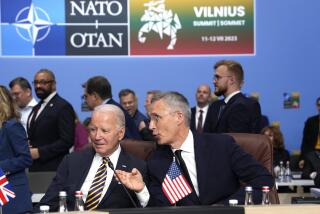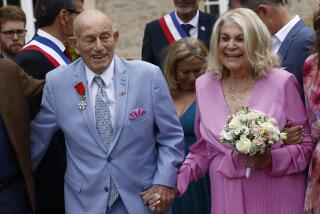Recalling Lives Lost, Liberty Gained
COLLEVILLE-SUR-MER, France — Amid the stillness of the graves above Omaha Beach, President Bush on Monday summoned the memory of the American sacrifice that liberated Europe 58 years ago to stir another alliance now joined to fight terrorism.
He spoke of heartbreak at home, of dedication to liberty far away, and said, “Our security is still bound up together in a transatlantic alliance, with soldiers in many uniforms defending the world from terrorists at this very hour.”
The president gave two short, understated speeches on a gray, wet Memorial Day that emphasized the task to which he has dedicated his administration: winning the anti-terrorism campaign that began with the attacks on Sept. 11.
With French President Jacques Chirac seated in a front pew of the stone church of Sainte-Mere-Eglise, the first village liberated on D-day, June 6, 1944, Bush said that the fight against terrorism will require “a sacrifice I can promise you we’ll make.”
The alliance the United States assembled after Sept. 11, he said, defends “our freedoms against people who can’t stand freedom.”
In the American Cemetery here, the president approached the podium alone and unannounced, striding amid white marble grave markers. The Latin crosses interspersed with occasional Stars of David, each decorated for the occasion with U.S. and French flags, are row upon row a fearful reminder of loss. They face west over the Norman countryside, toward the Atlantic, toward home.
“Words can only go so far in capturing the grief and sense of loss for the families of those who died in all our wars. For some military families in America and in Europe, the grief is recent, with the losses we have suffered in Afghanistan,” Bush said.
“They can know, however, that the cause is just and, like other generations, these sacrifices have spared many others from tyranny and sorrow.”
Continuing a Tradition
Bush followed a route well trod by presidents.
Jimmy Carter walked the beach on a cold January morning in 1978. On the 40th anniversary of D-day in 1984, Ronald Reagan delivered one of his most moving speeches, reminding the world of the sacrifices of “the boys of Pointe du Hoc.” They were the soldiers who climbed a 100-foot cliff to silence German artillery that held a commanding position.
Ten years later, Bill Clinton summoned the spirit of the heroes buried here to carry on new missions in defense of freedom--and to exorcise doubts about the leadership of a president who had not served in the military.
But the Sept. 11 attacks put this presidential visit on a different plane. It presented Bush a historical metaphor--and, with the 9,386 graves here, a graphic one--for a message he has delivered across the United States and now across Europe, from Germany to Moscow and on Monday above the beaches where a fading generation of Americans fought and fell in pursuit of a continent’s liberty.
He used the metaphor only sparingly at the cemetery. There, by custom, presidential speeches have focused on the broadest meaning of D-day and its enduring message of sacrifice for the freedom of the world.
“Here, where we stand today, the New World came back to liberate the Old. A bond was formed of shared trial and shared victory. And a light that scattered darkness from these shores and across France would spread to all of Europe--in time, turning enemies into friends, and the pursuits of war into the pursuits of peace,” Bush said.
He spoke of allies uniting to defend freedom at a time when many political leaders in Europe are facing mounting skepticism among their citizens about expanding the war on terrorism, perhaps to topple President Saddam Hussein of Iraq.
Before his speech here, Bush spent several minutes touring the battlefield atop the cliffs where the German guns had sat. He propped his umbrella against a wall, took the hand of his wife, Laura, and walked along a grassy bluff. They looked silently over the English Channel as the sound of waves below wafted over the beach and up the cliff. A military band played “America the Beautiful” in the distance.
The ceremony was short, no more than half an hour from Bush’s arrival to the moment when a U.S. Air Force F-15 disappeared straight up into the clouds as part of a missing-man formation.
‘It’s Always There’
The visit by a president born two years after D-day was a show of solidarity with an aging generation in the United States, for whom World War II defined a lifetime and for whom D-day was the pivotal moment.
Their representatives were here Monday in dwindling numbers. Isaac Phillips came from his home in Belgium, where he has lived for half a century after a youth spent in Georgia.
“Heartbreak,” he said, offering but one word to describe his emotions.
He said he had come ashore in chest-high water, his rifle held over his head, at Utah Beach. He was four days shy of his 20th birthday.
“Everything comes back, but everything, before it comes back, is always there,” he said. His unique accent is a thick soup, bred of the American South and Belgium, and he struggles now with his English after speaking French for so long.
“When you’re sleeping, when you’re eating, you can do anything, but it’s always there,” he said of his memories.
Those memories were ripe, too, for a Frenchman whom Lorry Gunhus, 66, a veteran of the Korean War, encountered Monday morning in a nearby village. Gunhus choked up telling the story.
The elderly man was wearing a baseball cap of a certain New York sports team, so Gunhus, visiting from his home in West Concord, Minn., asked whether he was a Yankee fan.
“I’m an America fan,” the man replied.
The first D-day assaults took place at the strand code-named Omaha Beach, reaching from Colleville-sur-Mer west to Vierville, roughly six miles, after a nighttime crossing of the English Channel.
The troops were pinned down by the Germans atop the cliffs, and half of those in the initial invading force died at the shoreline or on the beach. But by the evening of June 6, they had taken three villages from the occupying Germans.
West to Utah Beach and Pointe du Hoc, east to beaches whose code names are now the quirky-sounding facts of history--Gold Beach, Juno Beach, Sword Beach--the troops fought their way ashore, eventually to liberate Paris on Aug. 25, sending the Nazis into retreat and, nine months later, to surrender.
In the first hour, 135,000 troops and roughly 20,000 vehicles were brought ashore. Although the casualties at Omaha Beach would remain in public memory, the losses were smaller than military planners anticipated, according to histories of the invasion.
All told, there were 9,758 allied casualties attributed to the invasion, 6,603 of them American.
“Our wars have won for us every hour we live in freedom. Our wars have taken from us the men and women we honor today, and every hour of the lifetimes they had hoped to live,” Bush said.
“The day will come when no one is left who knew them, when no visitor to this cemetery can stand before a grave remembering a face and a voice. The day will never come when America forgets them,” he said.
A Town Remembers
Paratroopers from the 82nd and 101st Airborne divisions were dropped over Sainte-Mere-Eglise under the cover of darkness before D-day dawned.
Their attack was to have been a surprise. But a farmhouse fire had awakened the town, and most of the men died from German fire before landing.
Pvt. John Steele’s parachute became entangled in a church steeple, and he survived by pretending to be dead.
On Monday, hundreds of the town’s 1,612 residents gathered in the square to greet Bush and Chirac. Some displayed the French tricolor, and dozens of children held small American flags. In their fists, orange gerber daisies, pink peonies and roses, white calla lilies, and sprays of white, yellow and purple wildflowers added dots of color to the day.
The aged Norman church has been updated: The stained glass windows depict the liberation. One shows three paratroopers dressed in fatigues floating downward, with a barefoot Virgin Mary, baby Jesus in her arms, looming protectively over them.
Three town firemen, wearing the red scarves and shiny silvery helmets of their dress uniform, stood at attention in honor of the American firefighters who died Sept. 11.
In the photographs that form the current image of 1944 Normandy, the fields are gray, the farmhouses gray, the battered villages gray and charred, and a smoky pall hangs over all.
Today, the fields are a vivid green and peaceful, the highways are ribbons of commerce, not battle. The Hotel Mercure advertises “Golf Omaha Beach,” and in Bayeux, McDonald’s serves burgers.
And at the church in Sainte-Mere-Eglise, a mannequin hangs from the right steeple, caught by his snagged parachute: for new generations, an ever-present reminder of a mission completed long ago.
More to Read
Sign up for Essential California
The most important California stories and recommendations in your inbox every morning.
You may occasionally receive promotional content from the Los Angeles Times.










